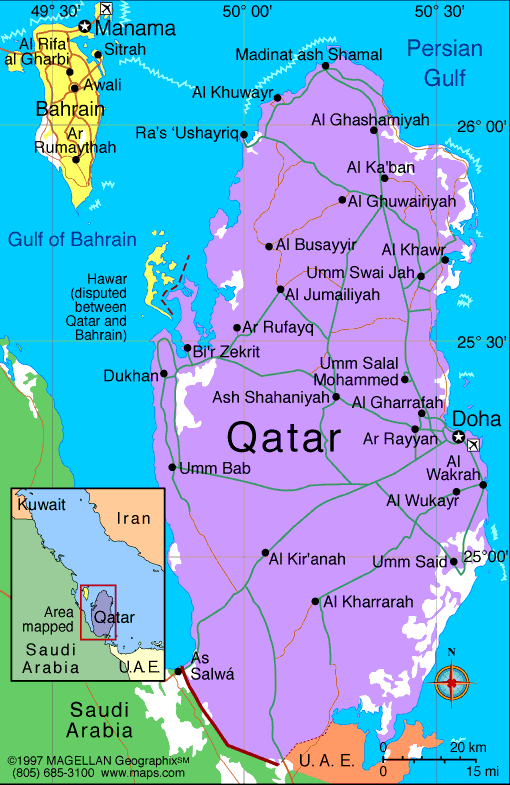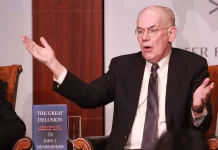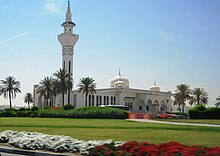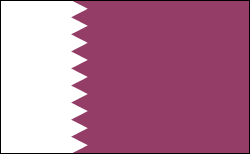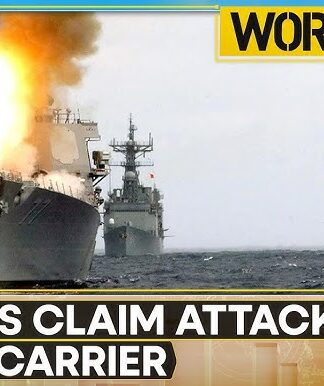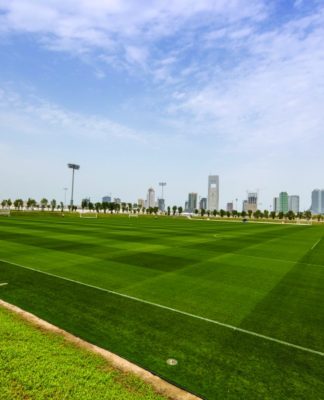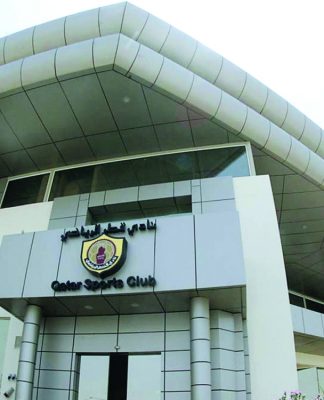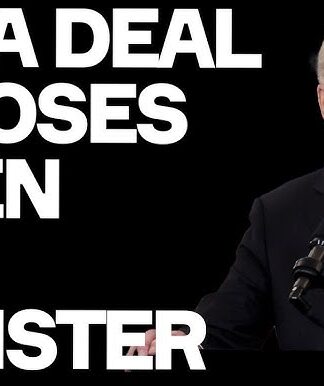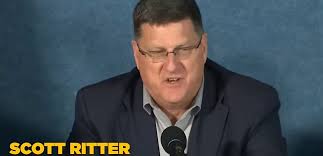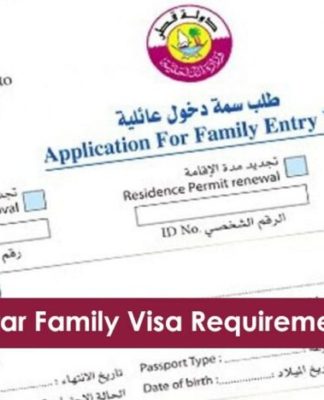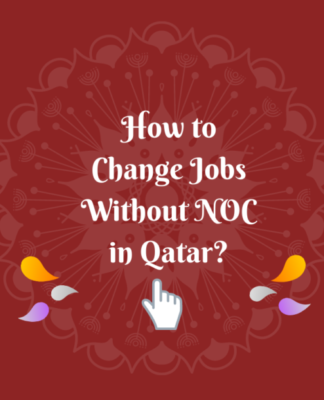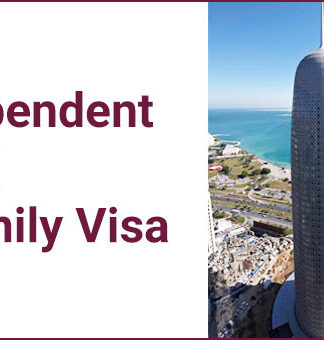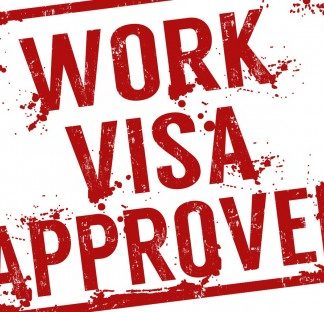-
#Qatar
Jump to navigationJump to search
State of QatarMotto: “الله الوطن الأمير” God, Nation, EmirAnthem: السلام الأميري
As-Salām al-ʾAmīrī (transliteration)
“Peace to the Amir”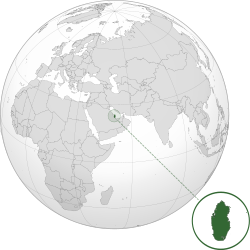 Location and extent of Qatar (dark green) on the Arabian Peninsula.
Location and extent of Qatar (dark green) on the Arabian Peninsula.Capital and largest cityDoha
25°18′N 51°31′EOfficial languages Arabic[1] Common languages English Ethnic groups (2015)[2]Religion (2020)[3]Demonym(s) Qatari Government Unitary parliamentary semi-constitutional monarchy (de jure)
Unitary absolute monarchy (de facto)[4]• EmirTamim bin Hamad Khalid bin Khalifa Legislature Consultative Assembly Establishment 18 December 1878 • Declared independence1 September 1971 • Independence from the United Kingdom3 September 1971 Area • Total11,581 km2 (4,471 sq mi) (158th) • Water (%)0.8 Population • 2020 estimate2,795,484[5] (139th) • 2010 census1,699,435[6] • Density176/km2 (455.8/sq mi) (76th) GDP (PPP) 2020 estimate • Total$357.338 billion[7] (51st) • Per capita$138,910[7] (4th) GDP (nominal) 2018 estimate • Total$183.807 billion[7] (56th) • Per capita$66,202[7] (6th) Gini (2007) 41.1[8]
mediumHDI (2019)  0.848[9]
0.848[9]
very high · 45thCurrency Qatari riyal (QAR) Time zone UTC+3 (AST) Driving side right[10] Calling code +974 ISO 3166 code QA Internet TLD Qatar (/ˈkætɑːr/,[11] /ˈkɑːtɑːr/ (
 listen), /ˈkɑːtər/ or /kəˈtɑːr/ (
listen), /ˈkɑːtər/ or /kəˈtɑːr/ ( listen);[12] Arabic: قطر, romanized: Qaṭar [ˈqatˤar]; local vernacular pronunciation: [ˈɡɪtˤɑr]),[13][14] officially the State of Qatar,[a] is a country in Western Asia. It occupies the small Qatar Peninsula on the northeastern coast of the Arabian Peninsula, and shares its sole land border with neighbouring Gulf Cooperation Council monarchy Saudi Arabia to the south, with the rest of its territory surrounded by the Persian Gulf. The Gulf of Bahrain, an inlet of the Persian Gulf, separates Qatar from nearby Bahrain. The capital is Doha, home to over 80% of the nation’s population.
listen);[12] Arabic: قطر, romanized: Qaṭar [ˈqatˤar]; local vernacular pronunciation: [ˈɡɪtˤɑr]),[13][14] officially the State of Qatar,[a] is a country in Western Asia. It occupies the small Qatar Peninsula on the northeastern coast of the Arabian Peninsula, and shares its sole land border with neighbouring Gulf Cooperation Council monarchy Saudi Arabia to the south, with the rest of its territory surrounded by the Persian Gulf. The Gulf of Bahrain, an inlet of the Persian Gulf, separates Qatar from nearby Bahrain. The capital is Doha, home to over 80% of the nation’s population.In early 2017, Qatar’s total population was 2.6 million: 313,000 Qatari citizens and 2.3 million expatriates.[15] Its official religion is Islam.[16] In terms of income, the country has the fourth-highest GDP (PPP) per capita in the world,[17] and the sixth-highest GNI per capita (Atlas method).[18] Qatar is classified by the United Nations as a country of very high human development, having the third-highest HDI in the Arab world.[19] It is a high-income economy, backed by the world’s third-largest natural gas reserves and oil reserves.[20] Qatar is the world’s largest exporter of liquefied natural gas,[21] and the world’s largest emitter of carbon dioxide per capita.[22]
Qatar has been ruled by the House of Thani since Mohammed bin Thani signed a treaty with the British in 1868 that recognised its separate status. Following Ottoman rule, Qatar became a British protectorate in the early 20th century until gaining independence in 1971. The hereditary emir of Qatar rules as an autocrat (currently, Tamim bin Hamad Al Thani) and holds all executive and legislative authority, as well as controlling the judiciary.[23] He appoints the prime minister and cabinet.[23]
In the 21st century, Qatar emerged as a significant power in the Arab world through its resource-wealth, as well as its globally expanding media group, Al Jazeera Media Network, and reportedly supporting several rebel groups financially during the Arab Spring.[24][25][26] For its size, Qatar wields disproportionate influence in the world, and has been identified as a middle power.[27][28] The 2022 FIFA World Cup will be held in Qatar, making it the first Muslim and Arab country to host the event.[29] The 2030 Asian Games will also be held in Qatar.[30]
Qatar’s flag in Libya after the Libyan Civil War; Qatar played an influential role during the Arab Spring.
Qatar’s international profile and active role in international affairs has led some analysts to identify it as a middle power. Qatar was an early member of OPEC and a founding member of the Gulf Cooperation Council (GCC). It is a member of the Arab League.[2] Diplomatic missions to Qatar are based in its capital, Doha.
Qatar’s regional relations and foreign policies are characterized by strategy of balancing and alliance building among regional and great powers. It maintains independent foreign policy and engages in regional balancing to secure its strategic priorities and to have recognition on the regional and international level.[143][144][145] As a small state in the gulf, Qatar established an “open-door” foreign policy where Qatar maintains ties to all parties and regional players in the region, including with organizations such as Taliban and Hamas.[146] The history of Qatar’s alliances provides insight into the basis of its foreign relations. Between 1760 and 1971, Qatar sought formal protection from the high transitory powers of the Ottomans, British, the Al-Khalifas from Bahrain, and from Saudi Arabia.[147][page needed]
Qatar has particularly strong ties with China,[148] Iran,[149] Turkey,[150] and the United States[151] as well as a number of Islamist movements in the Middle East such as the Muslim Brotherhood.[152][143][153] In June 2017, Saudi Arabia, the UAE, Bahrain, Egypt and Yemen broke diplomatic ties with Qatar, accusing Qatar of supporting terrorism.[154] The crisis escalated a dispute over Qatar’s support of the Muslim Brotherhood, which is considered a terrorist organization by some Arab nations.[155] The diplomatic crisis ended in January 2021 with the signing of AlUla declaration.[156]
Military

A Qatari Dassault Mirage 2000 flying over Libya
The Qatar Armed Forces are the military forces of Qatar. The country maintains a modest military force of approximately 11,800 men, including an army (8,500), navy (1,800) and air force (1,500). Qatar’s defense expenditures accounted for approximately 4.2% of gross national product in 1993, and 1.5% of gross domestic product in 2010, the most recent year available in the SIPRI statistical database.[157] Qatar has recently signed defense pacts with the United States and United Kingdom, as well as with France earlier in 1994. Qatar plays an active role in the collective defense efforts of the Gulf Cooperation Council; the other five members are Saudi Arabia, Kuwait, Bahrain, the UAE, and Oman. The presence of the large Al Udeid Air Base, operated by the United States and several other UN nations, provides a guaranteed source of defense and national security. In 2008 Qatar spent US$2.3 billion on military expenditures, 2.3% of the gross domestic product.[158] Qatari special forces have been trained by France and other Western countries, and are believed to possess considerable skill.[159] They also helped the Libyan rebels during the 2011 Battle of Tripoli.[159]
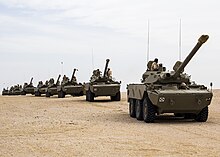
Qatar Armed Forces AMX-10 RC during a multilateral exercise in Qatar
The Stockholm International Peace Research Institute (SIPRI) found that in 2010–14 Qatar was the 46th-largest arms importer in the world. SIPRI writes that Qatar’s plans to transform and significantly enlarge its armed forces have accelerated. Orders in 2013 for 62 tanks and 24 self-propelled guns from Germany were followed in 2014 by a number of other contracts, including 24 combat helicopters and 3 early-warning-and-control aircraft from the US, and 2 tanker aircraft from Spain.[160] In 2015, Qatar was the 16th largest arms importer in the world, and in 2016, it was the 11th largest, according to SIPRI.[161]
Qatar’s military participated in the Saudi Arabian-led intervention in Yemen against the Shia Houthis. In 2015, Al Jazeera America reported: “Numerous reports suggest that the Saudi-led coalition against opposition groups in Yemen has indiscriminately attacked civilians and used cluster bombs in civilian-populated areas, in violation of international law.”[162] Many civilians have been killed and the large parts of the infrastructure in this region is now destroyed.[163] Hospitals have also been bombed by the Saudis and those operating with them.[164][165] Qatar was suspended from the coalition in Yemen due to the 2017 Qatar diplomatic crisis.
Administrative divisions
Since 2014, Qatar has been divided into eight municipalities (Arabic: baladiyah).[184]
For statistical purposes, the municipalities are further subdivided into 98 zones (as of 2015),[185] which are in turn subdivided into blocks.[186]
Former municipalities
- Al Jemailiya (until 2004)[187]
- Al Ghuwariyah (until 2004)[187]
- Jariyan al Batnah (until 2004)[187]
- Mesaieed (Umm Sa’id) (until 2006)[188]
Geography
The Qatari peninsula protrudes 160 kilometres (100 mi) into the Persian Gulf, north of Saudi Arabia. It lies between latitudes 24° and 27° N, and longitudes 50° and 52° E. Most of the country consists of a low, barren plain, covered with sand. To the southeast lies the Khor al Adaid (“Inland Sea“), an area of rolling sand dunes surrounding an inlet of the Persian Gulf. There are mild winters and very hot, humid summers.
The highest point in Qatar is Qurayn Abu al Bawl at 103 metres (338 ft)[2] in the Jebel Dukhan to the west, a range of low limestone outcroppings running north–south from Zikrit through Umm Bab to the southern border. The Jebel Dukhan area also contains Qatar’s main onshore oil deposits, while the natural gas fields lie offshore, to the northwest of the peninsula.
Biodiversity and environment
Arabian oryx, the national animal of QatarQatar signed the Rio Convention on Biological Diversity on 11 June 1992, and became a party to the convention on 21 August 1996.[189] It has subsequently produced a National Biodiversity Strategy and Action Plan, which was received by the convention on 18 May 2005.[190] A total of 142 fungal species have been recorded from Qatar.[191] A book recently produced by the Ministry of Environment documents the lizards known or believed to occur in Qatar, based on surveys conducted by an international team of scientists and other collaborators.[192]
According to the Emissions Database for Global Atmospheric Research, carbon dioxide emissions per person average over 30 tonnes, one of the highest in the world.[193] Qataris are also some of the highest consumers of water per capita per day, using around 400 litres.[194]
In 2008 Qatar launched its National Vision 2030 which highlights environmental development as one of the four main goals for Qatar over the next two decades. The National Vision pledges to develop sustainable alternatives to oil-based energy to preserve the local and global environment.[195]
Climate
hideClimate data for Qatar Month Jan Feb Mar Apr May Jun Jul Aug Sep Oct Nov Dec Year Average high °C (°F) 22
(72)23
(73)27
(81)33
(91)39
(102)42
(108)42
(108)42
(108)39
(102)35
(95)30
(86)25
(77)33
(92)Average low °C (°F) 14
(57)15
(59)17
(63)21
(70)27
(81)29
(84)31
(88)31
(88)29
(84)25
(77)21
(70)16
(61)23
(74)Average precipitation mm (inches) 12.7
(0.50)17.8
(0.70)15.2
(0.60)7.6
(0.30)2.5
(0.10)0
(0)0
(0)0
(0)0
(0)0
(0)2.5
(0.10)12.7
(0.50)71
(2.8)Source: http://us.worldweatheronline.com/doha-weather-averages/ad-dawhah/qa.aspx Sea Climate Data For Doha Month Jan Feb Mar Apr May Jun Jul Aug Sep Oct Nov Dec Year Average sea temperature °C (°F) 21.0
(69.8)19.4
(66.9)20.9
(69.6)23.3
(73.9)27.8
(82)30.5
(86.9)32.4
(90.3)33.6
(92.5)32.8
(91)30.8
(87.4)27.5
(81.5)23.5
(74.3)26.9
(80.5)Source:[196] Economy
Before the discovery of oil, the economy of the Qatari region focused on fishing and pearl hunting. A report prepared by local governors of Ottoman Empire in 1892 states that total income from pearl hunting in 1892 is 2,450,000 kran.[70] After the introduction of the Japanese cultured pearl onto the world market in the 1920s and 1930s, Qatar’s pearling industry crashed. Oil was discovered in Qatar in 1940, in Dukhan Field.[197] The discovery transformed the state’s economy. Now, the country has a high standard of living for its legal citizens. With no income tax, Qatar (along with Bahrain) is one of the countries with the lowest tax rates in the world. The unemployment rate in June 2013 was 0.1%.[198] Corporate law mandates that Qatari nationals must hold 51% of any venture in the emirate.[88] Trade and industry in the emirate is overseen by the Ministry of Business and Trade.[199]
As of 2016, Qatar has the fourth highest GDP per capita in the world, according to the International Monetary Fund.[200] It relies heavily on foreign labor to grow its economy, to the extent that migrant workers compose 86% of the population and 94% of the workforce.[201][202] Qatar has been criticized by the International Trade Union Confederation.[203] The economic growth of Qatar has been almost exclusively based on its petroleum and natural gas industries, which began in 1940.[204] Qatar is the leading exporter of liquefied natural gas.[159] In 2012, it was estimated that Qatar would invest over $120 billion in the energy sector in the next 10 years.[205] The country was a member state of Organization of Petroleum Exporting Countries (OPEC), having joined in 1961, and having left in January 2019.[206]

High-rise buildings in Doha.
In 2012, Qatar retained its title of richest country in the world (according to per capita income) for the third time in a row, having first overtaken Luxembourg in 2010. According to the study published by the Washington-based Institute of International Finance, Qatar’s per capita GDP at purchasing power parity (PPP) was $106,000 (QR387,000) in 2012, helping the country retain its ranking as the world’s wealthiest nation. Luxembourg came a distant second with nearly $80,000 and Singapore third with per capita income of about $61,000. The research put Qatar’s GDP at $182bn in 2012 and said it had climbed to an all-time high due to soaring gas exports and high oil prices. Its population stood at 1.8 million in 2012. The same study published that Qatar Investment Authority (QIA), with assets of $115bn, was ranked 12th among the richest sovereign wealth funds in the world.[207]
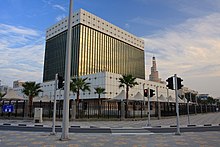
Qatar Central Bank‘s office in Doha.
Established in 2005, Qatar Investment Authority is the country’s sovereign wealth fund, specializing in foreign investment.[208] Due to billions of dollars in surpluses from the oil and gas industry, the Qatari government has directed investments into United States, Europe, and Asia Pacific. As of 2013, the holdings were valued at $100 billion in assets. Qatar Holding is the international investment arm of QIA. Since 2009, Qatar Holding has received $30–40bn a year from the state. As of 2014, it has investments around the world in Valentino, Siemens, Printemps, Harrods, The Shard, Barclays Bank, Heathrow Airport, Paris Saint-Germain F.C., Volkswagen Group, Royal Dutch Shell, Bank of America, Tiffany, Agricultural Bank of China, Sainsbury’s, BlackBerry,[209] and Santander Brasil.[210][211]
The country has no taxes on non-companies,[212] but authorities have announced plans to levy taxes on junk food and luxury items. The taxes would be implemented on goods that harm the human body – for example, fast food, tobacco products, and soft drinks. The rollout of these initial taxes is believed to be due to the fall in oil prices and a deficit that the country faced in 2016. Additionally, the country has seen job cuts in 2016 from its petroleum companies and other sectors in the government.[213][214]
Energy

Oryx GTL plant in Qatar
As of 2012, Qatar has proven oil reserves of 15 billion barrels and gas fields that account for more than 13% of the global resource. As a result, it is the richest state per-capita in the world. None of its 2 million residents live below the poverty line and less than 1% are unemployed.[215]
Qatar’s economy was in a downturn from 1982 to 1989. OPEC quotas on crude oil production, the lower price for oil, and the generally unpromising outlook on international markets reduced oil earnings. In turn, the Qatari government’s spending plans had to be cut to match lower income. The resulting recessionary local business climate caused many firms to lay off expatriate staff. With the economy recovering in the 1990s, expatriate populations, particularly from Egypt and South Asia, have grown again.
Oil production will not remain at the peak level of 500,000 barrels (80,000 m3) per day for long as the national oil fields are projected to be largely depleted by 2023. Large natural gas reserves have, however, been located off Qatar’s northeast coast. Qatar’s proved reserves of gas are the third-largest in the world, exceeding 250 trillion cubic feet (7,000 km3). The economy was boosted in 1991 by completion of the $1.5-billion Phase I of North Field gas development. In 1996, the Qatargas project began exporting liquefied natural gas (LNG) to Japan. Further phases of North Field gas development costing billions of dollars are in various stages of planning and development.
Qatar’s heavy industrial projects, all based in Umm Said, include a refinery with a 50,000 barrels (8,000 m3) per day capacity, a fertiliser plant for urea and ammonia, a steel plant, and a petrochemical plant. All these industries use gas for fuel. Most are joint ventures between European and Japanese firms and the state-owned Qatar General Petroleum Corporation (QGPC). The US is the major equipment supplier for Qatar’s oil and gas industry, and US companies are playing a major role in North Field gas development.[215]
Qatar’s National Vision 2030 has made investment in renewable resources a major goal for the country over the next two decades.[195] Qatar pursues a vigorous programme of “Qatarisation“, under which all joint venture industries and government departments strive to move Qatari nationals into positions of greater authority. Growing numbers of foreign-educated Qataris, including many educated in the US, are returning home to assume key positions formerly occupied by expatriates. To control the influx of expatriate workers, Qatar has tightened the administration of its foreign manpower programmes over the past several years. Security is the principal basis for Qatar’s strict entry and immigration rules and regulations.[215]
Transport
With a fast-expanding population and substantial economic growth over the past decade, a reliable and extensive transportation network is becoming increasingly necessary within Qatar. So far the government, the primary transport developer, has done well in terms of keeping up with the demand for new transportation options. In 2008 the Public Works Authority (Ashghal), one of the bodies that oversees infrastructure development, underwent a major reorganisation in order to streamline and modernise the authority in preparation for major project expansions across all segments in the near future. Ashghal works in tandem with the Urban Planning and Development Authority (UPDA), the body that designed the transportation master plan, instituted in March 2006 and running to 2025.
As driving is the primary mode of transport in Qatar, the road network is a major focus of the plan. Project highlights in this segment include the multibillion-dollar Doha Expressway and the Qatar Bahrain Causeway, which would connect Qatar to Bahrain and Saudi Arabia.

Qatar Airways Airbus A380, Qatar Airways, one of the world’s largest airlines, links over 150 international destinations from its base in Doha.
Mass-transit options, such as a Doha metro, light-rail system and more extensive bus networks, are also under development to ease road congestion. In addition, the railway system is being significantly expanded and could eventually form an integral part of a GCC-wide network linking all the Arab states of the Persian Gulf. The airport, too, is expanding capacity to keep up with rising visitor numbers.
Hamad International Airport is the international airport of Doha. In 2014, it replaced the former Doha International Airport as Qatar’s principal airport. In 2016, the airport was named the 50th busiest airport in the world by passenger traffic, serving 37,283,987 passengers, a 20.2% increase from 2015.
Qatar is increasingly activating its logistics and ports in order to participate in trade between Europe and China or Africa. For this purpose, ports such as Hamad Port are rapidly expanded and investments are made in their technology. The country is historically and currently part of the Maritime Silk Road that runs from the Chinese coast to the south via the southern tip of India to Mombasa, from there through the Red Sea via the Suez Canal to the Mediterranean, there to the Upper Adriatic region to the northern Italian hub of Trieste with its rail connections to Central Europe, Eastern Europe and the North Sea.[216][217][218] Hamad Port is Qatar’s main seaport, located south of Doha in the Umm Al Houl area. Construction of the port began in 2010; it became operational in December 2016. It was officially opened in September 2017, and is expected to become fully operational by 2020.[219] Capable of handling up to 7.8 million tonnes of products annually, the bulk of trade which passes through the port consists of food and building materials.[220] On the northern coast, Ras Laffan Port serves as the most extensive LNG exporting facility in the world.[221]
Qatar Airways is one of the largest airlines in the world that serves in six continents connecting more than 160 destinations every day. Besides, it has won Airline of the Year in 2011, 2012, 2015, 2017 and 2019 due to its outstanding performance and employs more than 46,000 professionals.[222][223]
Demographics
Skyline of Doha, capital and largest city of Qatar
Historical population Year Pop. ±% 1950 25,000 — 1960 47,000 +88.0% 1970 110,000 +134.0% 1980 224,000 +103.6% 1990 476,000 +112.5% 2000 592,000 +24.4% 2010 1,856,000 +213.5% 2019 2,832,000 +52.6% source:[224][225] The number of people in Qatar fluctuates considerably depending on the season, since the country relies heavily on migrant labour. In early 2017, Qatar’s total population was 2.6 million, with foreigners making up a vast majority of Qatar’s population. Only 313,000 of the population (12%) were Qatari citizens, while the remaining 2.3 million (88%) were expatriates.[15]
The combined number of South Asians (from the countries of the Indian subcontinent including Sri Lanka) by themselves represent over 1.5 million people (60%) of Qatar’s population. Among these, Indians are the largest community, numbering 650,000 in 2017,[15] followed by 350,000 Nepalis, 280,000 Bangladeshis, 145,000 Sri Lankans, and 125,000 Pakistanis. The contingent of expatriates which are not of South Asian origin represent around 28% of Qatar’s population, of which the largest group is 260,000 Filipinos and 200,000 Egyptians, plus many other nationalities (including nationals of other Arab countries, Europeans, etc.).[15]

Residential buildings at the Pearl
Qatar’s first demographic records date back to 1892, and were conducted by Ottoman governors in the region. Based on this census, which includes only the residents in cities, the total population in 1892 was 9,830.[70] The 2010 census recorded the total population at 1,699,435.[6] In January 2013, the Qatar Statistics Authority estimated the country’s population at 1,903,447, of which 1,405,164 were males and 498,283 females.[226] At the time of the first census, held in 1970, the population was 111,133.[227] The population has tripled in the decade to 2011, up from just over 600,000 people in 2001, leaving Qatari nationals as less than 15% of the total population.[228] The influx of male labourers has skewed the gender balance, and women are now just one-quarter of the population.
Projections released by the Qatar Statistical Authority indicate that the total population of Qatar could reach 2.8 million by 2020. Qatar’s National Development Strategy (2011–16) had estimated that the country’s population would reach 1.78m in 2013, 1.81m in 2014, 1.84m in 2015 and 1.86m in 2016 – the yearly growth rate being merely 2.1%. But the country’s population has soared to 1.83 million by the end of 2012, showing 7.5% growth over the previous year.[229] Qatar’s total population hit a record high of 2.46 million in November 2015, an increase of 8.5% from the previous year, far exceeding official projections.[230]
Religion
Islam is Qatar’s predominant religion and is the state religion although not the only religion practiced in the country.[231] Most Qatari citizens belong to the Salafi Muslim movement of Wahhabism,[232][233][234] and between 5–15% of Muslims in Qatar follow Shia Islam with other Islamic sects being very small in number.[235] In 2010, Qatar’s population was 67.7% Muslim, 13.8% Christian, 13.8% Hindu, and 3.1% Buddhist; other religions and religiously unaffiliated people accounted for the remaining 1.6%.[236] Sharia law is the main source of Qatari legislation according to Qatar’s Constitution.[117][118]
The vision of the Ministry of Awqaf and Islamic Affairs (Qatar) is “to build a contemporary Islamic society along with fostering the Sharee’ah and cultural heritage”.[237]
The non-Muslim population is composed almost entirely of foreigners. Since 2008, Christians have been allowed to build churches on ground donated by the government,[238] though foreign missionary activity is officially discouraged.[239] Active churches include the Mar Thoma Church, Malankara Orthodox Syrian Church, the Roman Catholic Church of Our Lady of the Rosary and the Anglican Church of the Epiphany.[240][241][242] There are also two Mormon wards.[240][241][242]
Languages
Arabic is the official language of Qatar, with Qatari Arabic the local dialect. Qatari Sign Language is the language of the deaf community. English is commonly used as a second language,[243] and a rising lingua franca, especially in commerce, to the extent that steps are being taken to try to preserve Arabic from English’s encroachment.[244] English is particularly useful for communication with Qatar’s large expatriate community. In the medical community, and in situations such as the training of nurses to work in Qatar, English acts as a lingua franca.[245] Reflecting the multicultural make-up of the country, many other languages are also spoken, including Persian, Baluchi, Brahui, Hindi, Malayalam, Urdu, Pashto, Kannada, Tamil, Telugu, Nepali, Sinhalese, Bengali, Tagalog, Tulu and Indonesian.[246]
In 2012, Qatar joined the international French-speaking organisation of La Francophonie (OIF) as a new associate member, but in December 2013, the French daily Le Monde revealed that Qatar, which has very few native French speakers, had not yet paid any contribution to the OIF,[247] while the outgoing Administrator of the OIF complained in 2015 that Qatar had not kept any of the promises it made when it joined the organisation and had never paid its annual membership fees.[248]
Healthcare
Healthcare standards in Qatar are generally high. Qatari citizens are covered by a national health insurance scheme, while expatriates must either receive health insurance from their employers, or in the case of the self-employed, purchase insurance.[249] Qatar’s healthcare spending is among the highest in the Middle East, with $4.7 billion being invested in healthcare in 2014.[250] This was a $2.1 billion increase from 2010.[251] The premier healthcare provider in the country is the Hamad Medical Corporation, established by the government as a non-profit healthcare provider, which runs a network of hospitals, an ambulance services, and a home healthcare service, all of which are accredited by the Joint Commission.
In 2010, spending on healthcare accounted for 2.2% of the country’s GDP; the highest in the Middle East.[252] In 2006, there were 23.12 physicians and 61.81 nurses per 10,000 inhabitants.[253] The life expectancy at birth was 82.08 years in 2014, or 83.27 years for males and 77.95 years for females, rendering it the highest life expectancy in the Middle East.[254] Qatar has a low infant mortality rate of 7 in 100,000.[255]
In 2006, there were a total of 25 beds per 10,000 people, and 27.6 doctors and 73.8 nurses per 10,000 people.[256] In 2011, the number of beds decreased to 12 per 10,000 people, whereas the number of doctors increased to 28 per 10,000 people. While the country has one of the lowest proportions of hospital beds in the region, the availability of physicians is the highest in the GCC.[257]
Culture
Qatar’s culture is similar to other countries in Eastern Arabia, being significantly influenced by Islam. Qatar National Day, hosted annually on 18 December, has had an important role in developing a sense of national identity.[258] It is observed in remembrance of Jassim bin Mohammed Al Thani‘s succession to the throne and his subsequent unification of the country’s various tribes.[259][260] Since 1 July 2008, Hamad Bin Abdulaziz Al-Kawari has been the Minister for Culture, Arts and Heritage of Qatar.
Arts and museums
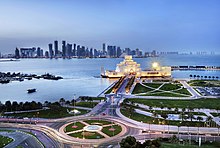
Museum of Islamic Art in Doha
Several senior members of Qatar’s ruling Al Thani family are noted collectors of Islamic and contemporary art.
The Museum of Islamic Art, opened in 2008, is regarded as one of the best museums in the region.[261] This, and several other Qatari museums, like the Arab Museum of Modern Art, falls under the Qatar Museums Authority (QMA) which is led by Sheikha Al-Mayassa bint Hamad bin Khalifa Al-Thani, the sister of the ruling Emir of the State of Qatar, and the prominent collector and art patron Sheikh Hassan bin Mohammed Al Thani.[262] The QMA also sponsors artistic events abroad, such as major exhibitions by Takahashi Murakami in Versailles (2010) and Damien Hirst in London (2012).
Qatar is the world’s biggest buyer in the art market by value.[263] The Qatari cultural sector is being developed to enable the country to reach world recognition to contribute to the development of a country that comes mainly from its resources from the gas industry.[264]
The National Museum of Qatar was opened to the public on 28 March 2019.[265]
Literature

Qatar National Library in Doha
Qatari literature traces its origins back to the 19th century. Originally, written poetry was the most common form of expression. Abdul Jalil Al-Tabatabai and Mohammed bin Abdullah bin Uthaymeen, two poets dating back to the early 19th century, formed the corpus of Qatar’s earliest written poetry. Poetry later fell out of favor after Qatar began reaping the profits from oil exports in the mid-20th century and many Qataris abandoned their Bedouin traditions in favor of more urban lifestyles.[266]
Due to the increasing number of Qataris who began receiving formal education during the 1950s and other significant societal changes, 1970 witnessed the introduction of the first short story anthology, and in 1993 the first locally authored novels were published. Poetry, particularly the predominant nabati form, retained some importance but would soon be overshadowed by other literary types.[266] Unlike most other forms of art in Qatari society, females have been involved in the modern literature movement on a similar magnitude to males.[267]
Media

The news desk of Al Jazeera English, a Qatari news channel
Qatar’s media was classified as “not free” in the 2014 Freedom of the Press report by Freedom House.[268] TV broadcasting in Qatar was started in 1970.[269] Al Jazeera is a main television network headquartered in Doha, Qatar. Al Jazeera initially launched in 1996 as an Arabic news and current affairs satellite TV channel of the same name, but has since expanded into a global network of several speciality TV channels known collectively as the Al Jazeera Media Network.
It has been reported that journalists practice self-censorship, particularly in regards to the government and ruling family of Qatar.[270] Criticism of the government, Emir and ruling family in the media is illegal. According to article 46 of the press law “The Emir of the state of Qatar shall not be criticised and no statement can be attributed to him unless under a written permission from the manager of his office.”[271] Journalists are also subject to prosecution for insulting Islam.[268]
In 2014, a Cybercrime Prevention Law was passed. The law is said to restrict press freedom and carries prison sentences and fines for broad reasons such as jeopardising local peace or publishing false news.[272] The Gulf Center for Human Rights has stated that the law is a threat to freedom of speech and has called for certain articles of the law to be revoked.[273]
Press media has undergone expansion in recent years. There are currently seven newspapers in circulation in Qatar, with four being published in Arabic and three being published in English.[274] There are also newspapers from India, Nepal and Sri Lanka with editions printed from Qatar.
In regards to telecommunication infrastructure, Qatar is the highest-ranked Middle Eastern country in the World Economic Forum’s Network Readiness Index (NRI) – an indicator for determining the development level of a country’s information and communication technologies. Qatar ranked number 23 overall in the 2014 NRI ranking, unchanged from 2013.[275]
Music
The music of Qatar is based on Bedouin poetry, song and dance. Traditional dances in Doha are performed on Friday afternoons; one such dance is the Ardah, a stylised martial dance performed by two rows of dancers who are accompanied by an array of percussion instruments, including al-ras (a large drum whose leather is heated by an open fire), tambourines and cymbals with small drums.[276] Other percussion instruments used in folk music include galahs (a tall clay jar) and tin drinking cups known as tus or tasat, usually used in conjunction with a tabl, a longitudinal drum beaten with a stick.[277] String instruments, such as the oud and rebaba, are also commonly used.[276]
Sport
Association football is the most popular sport in Qatar, both in terms of players and spectators.[278] Shortly after the Qatar Football Association became affiliated with FIFA in 1970, one of the country’s earliest international accolades came in 1981 when the Qatar national under-20 team‘s emerged as runners-up to West Germany in that year’s edition of the FIFA World Youth Championship after being defeated 4–0 in the final. At the senior level, Qatar has played host to two editions of the AFC Asian Cup; the first coming being the 9th edition in 1988 and the second being the 15th edition held in 2011.[279] For the first time in the country’s history, the Qatar national football team won the AFC Asian Cup in the 2019 edition hosted in the UAE, beating Japan 3–1 in the final. They won all seven of their matches, conceding only a single goal throughout the tournament.[280]
On 2 December 2010, Qatar won their bid to host the 2022 FIFA World Cup, despite never previously qualifying for the FIFA World Cup Finals.[281] Local organisers are planning to build 9 new stadiums and expand 3 existing stadiums for this event. Qatar’s winning bid for the 2022 World Cup was greeted enthusiastically in the Persian Gulf region as it was the first time a country in the Middle East had been selected to host the tournament. However, the bid has been embroiled in much controversy, including allegations of bribery and interference in the investigation of the alleged bribery. European football associations have also objected to the 2022 World Cup being held in Qatar for a variety of reasons, from the impact of warm temperatures on players’ fitness, to the disruption it might cause in European domestic league calendars should the event be rescheduled to take place during winter.[282][283] In May 2014, Qatari football official Mohammed bin Hammam was accused of making payments totalling £3m to officials in return for their support for the Qatar bid.[284] However, a FIFA inquiry into the bidding process in November 2014 cleared Qatar of any wrongdoing.[285]
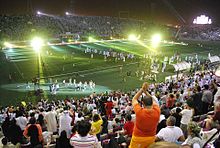
Qatar Emir Cup in 2009
The Guardian, a British national daily newspaper, produced a short documentary named “Abuse and exploitation of migrant workers preparing emirate for 2022”.[286] A 2014 investigation by The Guardian reports that migrant workers who have been constructing luxurious offices for the organisers of the 2022 World Cup have not been paid in over a year, and are now “working illegally from cockroach-infested lodgings.”[287] For 2014, Nepalese migrants involved in constructing infrastructure for the 2022 World Cup died at a rate of one every two days.[288] The Qatar 2022 organising committee have responded to various allegations by claiming that hosting the World Cup in Qatar would act as a “catalyst for change” in the region.[289]
Qatar was estimated to host a football fanbase of 1.6 million for the 2022 FIFA World Cup 2022. However, the construction work in country was expected to only take the available 37,000 hotel rooms to 70,000 by the end of 2021. In December 2019, the Qatari World Cup officials approached the organizers of the Glastonbury Festival in England and the Coachella Festival in the US, to plan huge desert campsites for thousands of football fans. The World Cup campsites on the outskirts were reported to have licensed bars, restaurants, entertainment and washing facilities. Moreover, two cruise ships were also reserved as temporary floating accommodations for nearly 40,000 people during the tournament.[290]
Though football is the most popular sport, other team sports have experienced considerable success at senior level. In 2015, the national handball team emerged as runners-up to France in the World Men’s Handball Championship as hosts, however the tournament was marred by numerous controversies regarding the host nation and its team.[291] Further, in 2014, Qatar won the world championship in men’s 3×3 basketball.[292]
Khalifa International Tennis and Squash Complex in Doha hosted the WTA Tour Championships in women’s tennis between 2008 and 2010. Doha holds the WTA Premier tournament Qatar Ladies Open annually. Since 2002, Qatar has hosted the annual Tour of Qatar, a cycling race in six stages. Every February, riders are racing on the roads across Qatar’s flat land for six days. Each stage covers a distance of more than 100 km, though the time trial usually is a shorter distance. Tour of Qatar is organised by the Qatar Cycling Federation for professional riders in the category of Elite Men.[293]
The Qatar Army Skydiving Team has several different skydiving disciplines placing among the top nations in the world. The Qatar National Parachute team performs annually during Qatar’s National Day and at other large events, such as the 2015 World Handball Championship.[294] Doha four times was the host of the official FIVB Volleyball Men’s Club World Championship and three times host FIVB Volleyball Women’s Club World Championship. Doha one time Host Asian Volleyball Championship.[295]
On 3 September 2020, the Education City Stadium hosted its first-ever official match, where the local clubs Al Sadd SC and Al Kharaitiyat SC contested the season-opener of the 2020–21 Qatar Stars League.[296]
Education
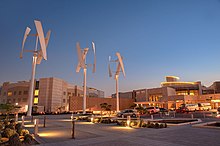
Student Center in Education City. Education City houses various educational facilities, including satellite campuses of eight international universities.
Qatar hired the RAND Corporation to reform its K–12 education system.[159] Through Qatar Foundation, the country has built Education City, a campus which hosts local branches of the Weill Cornell Medical College, Carnegie Mellon School of Computer Science, Georgetown University School of Foreign Service, Northwestern’s Medill School of Journalism, Texas A&M’s School of Engineering, Virginia Commonwealth University School of the Arts and other Western institutions.[159][297]
The illiteracy rate in Qatar was 3.1% for males and 4.2% for females in 2012, the lowest in the Arab-speaking world, but 86th in the world.[298] Citizens are required to attend government-provided education from kindergarten through high school.[299] Qatar University, founded in 1973, is the country’s oldest and largest institution of higher education.[300][301]
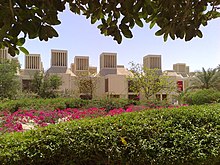
Qatar University, east view
In November 2002, emir Hamad bin Khalifa Al Thani created The Supreme Education Council.[302] The Council directs and controls education for all ages from the pre-school level through the university level, including the “Education for a New Era” initiative which was established to try to position Qatar as a leader in education reform.[303][304] According to the Webometrics Ranking of World Universities, the top-ranking universities in the country are Qatar University (1,881st worldwide), Texas A&M University at Qatar (3,905th) and Weill Cornell Medical College in Qatar (6,855th).[305]
In 2009, Qatar established the Qatar Science & Technology Park in Education City to link those universities with industry. Education City is also home to a fully accredited international Baccalaureate school, Qatar Academy. In addition, two Canadian institutions, the College of the North Atlantic (headquarters in Newfoundland and Labrador) and the University of Calgary, have inaugurated campuses in Doha. Other for-profit universities have also established campuses in the city.[306]
In 2012, Qatar was ranked third from the bottom of the 65 OECD countries participating in the PISA test of maths, reading and skills for 15- and 16-year-olds, comparable to Colombia or Albania, despite having the highest per capita income in the world.[307][308] Qatar was ranked 70th in the Global Innovation Index in 2020, down from 65th in 2019.[309][310][311][312]
As part of its national development strategy, Qatar has outlined a 10-year strategic plan to improve the level of education.[313] The government has launched educational outreach programs, such as Al-Bairaq. Al-Bairaq was launched in 2010 aims to provide high school students with an opportunity to experience a research environment in the Center for Advanced Materials in Qatar University. The program encompasses the STEM fields and languages.[314]
Science and technology
Launched in 2006 as part of an initiative of the quasi-governmental Qatar Foundation, the Qatar National Research Fund was created with the intent of securing public funds for scientific research within the country. The fund functions as a means for Qatar to diversify its economy from a primarily oil and gas-based one to a knowledge-based economy.[315]
The Qatar Science & Technology Park (QSTP) was established by Qatar Foundation in March 2009 as an attempt to assist the country’s transition towards a knowledge economy.[316][317] With a seed capital of $800 million and initially hosting 21 organizations,[317] the QSTP became Qatar’s first free-trade zone.[318]
- re are more people here than ever”. DohaNews.Co. Doha News. Archived from the original on 18 January 2016. Retrieved 17 January 2016.
- ^ “Report on International Religious Freedom – Qatar”. US Department of State. Archived from the original on 21 August 2014.
The official state religion follows the conservative Wahhabi tradition of the Hanbali school of Islam
- ^ “Tiny Qatar’s growing global clout”. BBC. 30 April 2011. Retrieved 12 March 2015.
- ^ “Qatar’s modern future rubs up against conservative traditions”. Reuters. 27 September 2012.
- ^ “Rising power Qatar stirs unease among some Mideast neighbors”. Reuters. 12 February 2013. Retrieved 13 June 2013.
- ^ “2011 Report on International Religious Freedom – Qatar”. US Department of State.
- ^ “Religious Composition by Country” (PDF). Global Religious Landscape. Pew Forum. Archived from the original (PDF) on 9 March 2013. Retrieved 9 July 2013.
- ^ “Christians to Welcome Qatar’s First Christian Church”. Christianpost.com. 24 February 2008. Retrieved 22 January 2013.
- ^ “CIA The World Fact Book”. State.gov. 29 June 2006. Retrieved 28 March 2010.
- ^ Jump up to:a b “Report on Qatar”. Cumorah Project. Retrieved 12 March 2015.
- ^ Jump up to:a b “The Anglican Centre in Qatar”. Epiphany-qatar.org. Archived from the original on 16 January 2013. Retrieved 22 January 2013.
- ^ Jump up to:a b David B. Barrett; George Thomas Kurian; Todd M. Johnson (2001). World Christian encyclopedia: a comparative survey of churches and religions in the modern world. Vol. 1. Oxford University Press. p. 617. ISBN 978-0-19-510318-2.
- ^ Baker, Colin; Jones, Sylvia Prys (1998). Encyclopedia of Bilingualism and Bilingual Education. Multilingual Matters. p. 429. ISBN 978-1853593628.
- ^ Guttenplan, D. D. (11 June 2012). “Battling to Preserve Arabic From English’s Onslaught”. The New York Times. Retrieved 24 November 2013.
- ^ Tweedie, Gregory; Johnson, Robert. “Listening instruction and patient safety: Exploring medical English as a lingua franca (MELF) for nursing education”. Retrieved 6 January 2018.
- ^ “Qatar Facts”. First Qatar Orthodontic Conference. Archived from the original on 12 July 2014. Retrieved 23 January 2013.
- ^ Jacot, Martine (23 December 2013). “Le Qatar ne paie pas ses contributions à la francophonie”. Retrieved 5 June 2017 – via Le Monde.
- ^ “Clément Duhaime : “Le Qatar n’a pas tenu ses promesses” à l’OIF – JeuneAfrique.com”. 22 April 2015. Retrieved 5 June 2017.
- ^ “QATAR: Compulsory health insurance leaves window for treatment abroad”. International Medical Travel Journal. 21 October 2013. Retrieved 23 July 2015.
- ^ “Qatar’s 2015 healthcare expenditure worth $5.2bn”. Arabian Business. 13 July 2015. Retrieved 23 July 2015.
- ^ Shane McGinley (30 July 2012). “Qatar is MidEast’s biggest healthcare spender”. Arabian Business. Retrieved 23 July 2015.
- ^ Shane McGinley (30 July 2012). “Qatar is MidEast’s biggest healthcare spender”. Arabian Business. Retrieved 3 July 2015.
- ^ “Health report”. World Health Organization. Retrieved 12 March 2015.
- ^ “Life expectancy in the Middle East”. World Life Expectancy. Retrieved 12 March 2015.
- ^ “Mortality rate, infant (per 1,000 live births)”. The World Bank. Retrieved 12 March 2015.
- ^ “Healthcare in Qatar”. Allianz. Retrieved 23 July 2015.
- ^ “Report: Qatar’s healthcare sector the fastest growing in the region”. Doha News. 25 April 2014. Retrieved 23 July 2015.
- ^ Kamrava, Mehran (2013). Qatar: Small State, Big Politics. Cornell University Press. ISBN 978-0801452093.
- ^ “Qatar National Day 2011”. Time Out Doha. 29 November 2011. Retrieved 12 March 2015.
- ^ “Everything you need to know about Qatar National Day 2012”. Doha News. 10 December 2012. Archived from the original on 19 February 2015. Retrieved 18 February 2015.
- ^ “Art in Qatar: A Smithsonian in the sand”. The Economist. 1 January 2011. Retrieved 16 June 2013.
- ^ “QMA Board of Trustees”. Qatar Museums Authority. Archived from the original on 2 April 2015. Retrieved 12 March 2015.
- ^ “Qatar revealed as the world’s biggest contemporary art buyer”. The Art Newspaper. Archived from the original on 7 March 2015. Retrieved 16 June 2013.
- ^ Bohas, Alexander. “The Political Trump-Cards of Cultural Potency Qatar’s Policy of ‘Cultural Grandeur'”. Chaos International. Retrieved 13 April 2013.
- ^ New Qatar National Museum…a journey in a world of fantasy!
- ^ Jump up to:a b Hassan Tawfiq (1 May 2015). الشعر في قطر علي امتداد مائة سنة (in Arabic). Al Jasra Cultural and Social Club. Retrieved 29 August 2018.
- ^ Muḥammad Muṣṭafá Badawī; Muhammad Mustafa Badawi; M. M. Badawi; María Rosa Menocal; Raymond P. Scheindlin & Michael Sells (1992). Modern Arabic Literature. Vol. 3. Cambridge University Press. p. 448. ISBN 9780521331975.
- ^ Jump up to:a b “Qatar Freedom of the Press”. Freedom House. Archived from the original on 30 March 2019. Retrieved 19 January 2015.
- ^ Barrie Gunter; Roger Dickinson (6 June 2013). News Media in the Arab World: A Study of 10 Arab and Muslim Countries. A&C Black. p. 33. ISBN 978-1-4411-0239-3. Retrieved 8 February 2014.
- ^ Blanchard, Christoper (2014). Qatar: Background and U.S. Relations. Congressional Research Service. p. 17. ISBN 9781437987089.
- ^ Roth, Richard J. (8 May 2013). “Awaiting a Modern Press Law in Qatar”. The New York Times. Retrieved 16 June 2013.
- ^ “New cybercrime law could have serious consequences for press freedom in Qatar”. cpj.org. 27 September 2014. Retrieved 19 January 2015.
- ^ “Qatar: New Cyber Crime Law poses real threat to Freedom of Expression”. gc4hr.org. 17 September 2014. Retrieved 19 January 2015.
- ^ The Report: Qatar 2010. Oxford Business Group. 2010. p. 237. ISBN 9781907065446.
- ^ “NRI Overall Ranking 2014” (PDF). World Economic Forum. Retrieved 28 June 2014.
- ^ Jump up to:a b “Arts and Culture”. Embassy of Qatar in London. Retrieved 25 June 2015.
- ^ “Heritage and Culture”. Qatar e-Gov. Archived from the original on 4 March 2015. Retrieved 26 April 2015.
- ^ “Qatar – a Sporting Nation”. Qatar e-Government. Retrieved 12 March 2015.
- ^ Gibbes, Martin; Schiller, Emma (4 January 2011). “Fox Sports brings you everything you need to know – and a few things you don’t – about the Asian Cup”. Fox Sports. Retrieved 12 March 2015.
- ^ “Qatar stun Japan with 3–1 win to be crowned Asian Cup champions”. Guardian. 1 February 2019. Retrieved 5 February 2019.
- ^ Paul Radford (2 December 2010). “Russia, Qatar win 2018 and 2022 World Cups”. Reuters. Archived from the original on 5 December 2010. Retrieved 2 December 2010.
- ^ “Europe’s Top Leagues protest against 2022 winter World Cup in Qatar”. Qatar Chronicle. 12 August 2013. Archived from the original on 17 August 2013. Retrieved 21 August 2013.
- ^ “Fifa wants Qatar 2022 postponed to Winter”. Qatar Chronicle. 20 July 2013. Archived from the original on 10 November 2014. Retrieved 21 August 2013.
- ^ “BBC Sport – Qatar World Cup: ‘£3m payments to officials’ corruption claim”. Bbc.co.uk. Retrieved 1 June 2014.
- ^ “World Cup inquiry clears Qatar but criticises English FA”. BBC. 13 November 2014. Retrieved 12 March 2015.
- ^ Pattisson, Pete (25 September 2013). “Revealed: Qatar’s World Cup ‘slaves'”. The Guardian. Retrieved 26 September 2013.
So entrenched is this exploitation that the Nepalese ambassador to Qatar, Maya Kumari Sharma, recently described the emirate as an “open jail”.
- ^ Booth, Robert; Pattisson, Pete (28 July 2014). “Qatar World Cup: migrants wait a year to be paid for building offices”. The Guardian. Retrieved 12 March 2015.
- ^ Owen Gibson and Pete Pattisson (23 December 2014). Death toll among Qatar’s 2022 World Cup workers revealed. The Guardian. Retrieved 29 May 2015.
- ^ Gibson, Owen (14 June 2014). “Qatar hits back at allegations of bribery over 2022 World Cup”. The Guardian. Retrieved 12 March 2015.
- ^ “Football fans to sleep in Glastonbury-like tented villages at Qatar World Cup”. The Florida Post. Retrieved 22 December 2019.
- ^ “Match report” (PDF). International Handball Federation. Archived from the original (PDF) on 1 February 2015. Retrieved 12 March 2015.
- ^ “2014 FIBA 3×3 World Championships”. International Basketball Federation. Archived from the original on 31 October 2015. Retrieved 13 November 2015.
- ^ “The homepage of Tour of Qatar”. Letour.fr. 1 December 1994. Archived from the original on 16 January 2013. Retrieved 22 January 2013.
- ^ Gay, Chris. “Skydive Mag – Incredible Demo at Doha”. Retrieved 5 June 2017.
- ^ “QVA – Qatar Volleyball Association”. QVA. Retrieved 5 June 2017.
- ^ “Cazorla dazzles as football arrives at Education City”. FIFA. Retrieved 4 September 2020.
- ^ Anderson, Nick (6 December 2015). “The Education City contracts: A case study from VCU in Qatar”. Washington Post. Retrieved 14 March 2018.
- ^ “In the occasion of Literacy Arab Day, Qatar has the Lowest Illiteracy Rates in 2012”. Qatar Statistics Authority. 8 January 2013. Archived from the original on 24 September 2015. Retrieved 26 January 2013.
- ^ “Qatar constitution”. Archived from the original on 18 September 2013.
- ^ “Our history”. Qatar University. Retrieved 12 March 2015.
- ^ Hendengren, Adam (25 June 2013). “SPECIAL REPORT: UNIVERSITY STUDIES IN THE MIDDLE EAST”. Your Middle East. Retrieved 12 June 2015.
- ^ “World Data on Education – Qatar” (PDF). UNESCO. Retrieved 21 July 2015.
- ^ Anderson, Margery K.; Tarfa Nasser Alnaimi; Shaikha Hamad Alhajri (1 November 2010). “National student research fairs as evidence for progress in Qatar’s Education for a New Era”. Improving Schools. 13 (3): 235–248. doi:10.1177/1365480210390083. S2CID 144828063.
- ^ “Education for a New Era”. Supreme Education Council. Archived from the original on 13 September 2005. Retrieved 25 March 2008.
- ^ “Qatar”. Ranking Web of Universities. Retrieved 26 February 2013.
- ^ “NHL Stenden University Qatar”. Retrieved 22 May 2009.
- ^ PISA 2012 Results in Focus. OECD. 2014. p. 5.
- ^ “Key findings – Organisation for Economic Co-operation and Development”. Oecd.org. Retrieved 30 December 2013.
- ^ “Release of the Global Innovation Index 2020: Who Will Finance Innovation?”. www.wipo.int. Retrieved 2 September 2021.
- ^ “Global Innovation Index 2019”. www.wipo.int. Retrieved 2 September 2021.
- ^ “RTD – Item”. ec.europa.eu. Retrieved 2 September 2021.
- ^ “Global Innovation Index”. INSEAD Knowledge. 28 October 2013. Retrieved 2 September 2021.
- ^ “Qatar National Development Strategy 2011~2016” (PDF). Doha, Qatar: Gulf Publishing and Printing Company. March 2011. Archived from the original (PDF) on 2 April 2015. Retrieved 24 March 2015.
- ^ “Welcome to Al-Bairaq World”. Qu.edu.qa. 6 March 2014. Archived from the original on 19 April 2014. Retrieved 14 July 2014.
- ^ “QF partner Texas A&M at Qatar receives 11 QNRF grants for research to benefit Qatar”. Texas A&M University at Qatar. 26 January 2021. Retrieved 2 September 2021.
- ^ Julia Gremm, Julia Barth, Kaja J. Fietkiewicz, Wolfgang G. Stock (2017). Transitioning Towards a Knowledge Society. Springer International Publishing. p. 49.
- ^ Jump up to:a b Vineetha Menon (23 February 2009). “Qatar Foundation pumps $800 million into R&D hub”. Arabian Business. Retrieved 2 September 2021.
- ^ Lesley Walker (14 July 2015). “Qatari-Spanish JV win QR1.6bn contract to build new economic zone”. Doha News. Retrieved 2 September 2021.
Further reading
- Bianco, C. (2020a). The GCC monarchies: Perceptions of the Iranian threat amid shifting geopolitics. The International Spectator, 55(2), 92–107.
- Bianco, C. (2020b). A Gulf apart: How Europe can gain influence with the Gulf Cooperation Council. European Council on Foreign Relations, February 2020. Available at https://ecfr.eu/archive/page/-/a_gulf_apart_how_europe_can_gain_influence_with_gulf_cooperation_council.pdf.
- Bianco, C. (2021). Can Europe Choreograph a Saudi-Iranian Détente? European University Institute, Robert Schuman Center for Advanced Studies, Middle East Directions. Available at: https://cadmus.eui.eu/bitstream/handle/1814/70351/PB_2021_10-MED.pdf?sequence=1.
- Bianco, C., & Stansfield, G. (2018). The intra-GCC crises: Mapping GCC fragmentation after 2011. International Affairs, 94(3), 613–635.
- Miniaoui, Héla, ed. Economic Development in the Gulf Cooperation Council Countries: From Rentier States to Diversified Economies. Vol. 1. Springer Nature, 2020.
- Guzansky, Y., & Even, S. (2020). The economic crisis in the Gulf States: A challenge to the “contract” between rulers and ruled. INSS Insight No. 1327, June 1, 2020. Available at https://www.INSS.org.il/publication/gulf-states-economy/?offset=7&posts=201&outher=Yoel%20Guzansky.
- Guzansky, Y., & Marshall, Z. A. (2020). The Abraham accords: Immediate significance and long-term implications. Israel Journal of Foreign Affairs, 1–11.
- Guzansky, Y., & Segal, E. (2020). All in the family: Leadership changes in the Gulf. INSS Insight No. 1378, August 30, 2020. Available at: https://www.INSS.org.il/publication/gulf-royal-families/?offset=1&posts=201&outher=Yoel%20Guzansky
- Guzansky, Y., & Winter, O. (2020). Apolitical Normalization: A New Approach to Jews in Arab States. INSS Insight No. 1332, June 8, 2020. Available at: https://www.INSS.org.il/publication/judaism-in-the-arab-world/?offset=5&posts=201&outher=Yoel%20Guzansky.
- Tausch, Arno; Heshmati, Almas; Karoui, Hichem (2015). The political algebra of global value change. General models and implications for the Muslim world (1st ed.). New York: Nova Science. ISBN 978-1-62948-899-8. Available at: https://www.researchgate.net/publication/290349218_The_political_algebra_of_global_value_change_General_models_and_implications_for_the_Muslim_world
- Tausch, Arno (2021). The Future of the Gulf Region: Value Change and Global Cycles. Gulf Studies, Volume 2, edited by Prof. Mizanur Rahman, Qatar University (1st ed.). Cham, Switzerland: Springer. ISBN 978-3-030-78298-6.
- Woertz, Eckart. “Wither the self-sufficiency illusion? Food security in Arab Gulf States and the impact of COVID-19.” Food Security 12.4 (2020): 757-760.
- Zweiri, Mahjoob, Md Mizanur Rahman, and Arwa Kamal, eds. The 2017 Gulf Crisis: An Interdisciplinary Approach. Vol. 3. Springer Nature, 2020.
External links
- Amiri Diwan (official government website).
- Qatar. The World Factbook. Central Intelligence Agency.
- Qatar web resources provided by GovPubs at the University of Colorado Boulder Libraries
- Qatar at Curlie
- Qatar from the BBC News.
 Wikimedia Atlas of Qatar
Wikimedia Atlas of Qatar- Key Development Forecasts for Qatar from International Futures.
- Legal Portal by the Ministry of Justice, including official gazette.
Categories:- Qatar
- Arabian Peninsula
- Arabic-speaking countries and territories
- Emirates
- Member states of the Arab League
- Member states of the Gulf Cooperation Council
- Member states of the Organisation of Islamic Cooperation
- Current member states of the United Nations
- Middle Eastern countries
- Near Eastern countries
- Peninsulas of Asia
- States and territories established in 1971
- Western Asian countries
- Countries in Asia
- Former OPEC member states
- Emir: Sheikh Tamim ibn Hamad Al Thani (2013)
Prime Minister: Sheikh Abdullah ibn Nasser ibn Khalifah Al Thani (2013)
Total area: 4,416 sq mi (11,437 sq km)
Population (2014 est.): 2,123,160 (growth rate: 3.58%); birth rate: 9.95/1000; infant mortality rate: 6.42/1000; life expectancy: 78.38; density per sq mi: 455
Capital (2011 est.): Doha, 567,000
Monetary unit: Qatari riyal
National name: Dawlat Qatar
Languages: Arabic (official); English a common second language
Ethnicity/race: Arab 40%, Pakistani 18%, Indian 18%, Iranian 10%, other 14%
Religion: Religion Muslim 77.5%, Christian 8.5%, other 14% (2004 census)
Literacy rate: 96.3% (2010)
Economic summary: GDP/PPP (2013 est.): $198.7 billion; per capita $102,100. Real growth rate: 5.5%. Inflation: 3.1%. Unemployment: 0.3%. Arable land: 1.21%. Agriculture: fruits, vegetables; poultry, dairy products, beef; fish. Labor force: 1.424 million (2013 est.). Industries: liquefied natural gas, crude oil production and refining, ammonia, fertilizers, petrochemicals, steel reinforcing bars, cement, commercial ship repair. Natural resources: petroleum, natural gas, fish. Exports: $12.7 billion (2013 est.): liquefied natural gas (LNG), petroleum products, fertilizers, steel. Imports: $39.58 billion (2011 est.): machinery and transport equipment, food, chemicals. Major trading partners: Japan, South Korea, Singapore, India, Italy, China, France, U.S., Saudi Arabia, UAE, Germany, UK (2013).
Communications: Telephones: main lines in use: 327,000 (2012); mobile cellular: 2.6 million (2012). Radio broadcast stations: AM 6, FM 5, shortwave 1 (1998). Radios: 256,000 (1997). Television broadcast stations: 1 (2014). Televisions: 230,000 (1997). Internet Service Providers (ISPs): 897 (2012). Internet users: 563,800 (2009).
Transportation: Railways: 0 km. Highways: total: 9,830 km (2010). Ports and harbors: Doha, Mesaieed (Umaieed), Ra’s Laffan. Airports: 6 (2013).
International disputes: none.
- airport
- Cooking
- Arabic cooking
- Articles
- Aston Martin Vanquish
- Top 10
- Book
- Book of the week
- Breakfast
- Bugatti Veyron
- Business
- Car
- Career Articles
- Travel
- Cities in Qatar
- City
- Country
- News
- Crime News
- Drinks and ice cream
- Economic Articles
- Economic news
- Entertainment
- Environment
- Enzo Ferrari
- Famous People
- Finance Articles
- Financial News
- Food
- Football
- Game
- Health
- Health and Fitness
- Health news
- Hollywood News
- Horoscope
- Immigration
- Islam
- job
- Koenigsegg CCXR
- Lamborghini Reventon
- Maybach Landaulet
- McLaren F1
- Medical Articles
- Men
- modern cooking
- Movie
- Movies
- Music
- News of Welcome Qatar Company
- Pagani Zonda C12 F
- People
- Political News
- Porsche Carrera GT
- Qatar Articles
- Qatar Employment
- Qatar Football
- Qatar Football League
- Qatar News
- Qatar travel advice
- Qatari
- Relationship
- Salad
- Skin and Hair and Beauty
- Soccer
- Social Articles
- Social News
- Soup
- Sport News
- SSC Ultimate Aero
- Sweets and desserts
- Test
- Tourist Cities
- Universiti
- Video news
- visa
- war
- Women
- World
- World Cup 2022
- World News
#QatarFacts, History & News
